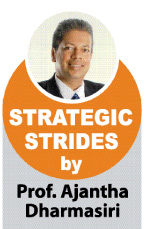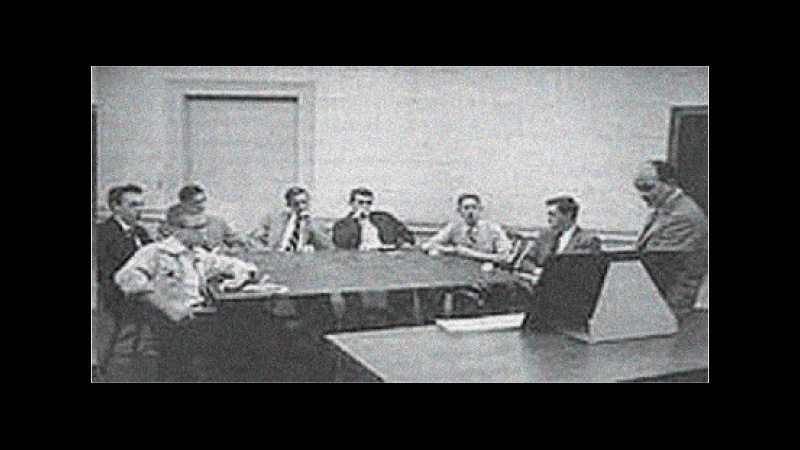 We often hail teams as a great way to achieve results. We say with conviction that together everyone achieves more. There is a flip side to working together. Groupthink occurs as a silent serpent that encroaches a synergistic team. The Asch Effect is one key phenomenon associated with such a scenario. Today’s column will shed light into this with relevance to Sri Lankan managers.
We often hail teams as a great way to achieve results. We say with conviction that together everyone achieves more. There is a flip side to working together. Groupthink occurs as a silent serpent that encroaches a synergistic team. The Asch Effect is one key phenomenon associated with such a scenario. Today’s column will shed light into this with relevance to Sri Lankan managers.
Overview
Let us be brilliant on basics. Teams and groups are often interchangeably used to describe a set of people working together. In perusing through the literature of Organisational Behaviour, veterans such as Stephen Robbins and Fred Luthans have identified a group as a set of two or more individuals interacting and interdependent with each other in achieving a common objective. A team is one step ahead. I would simplify a team as a group with synergy.
“Synergy means that the whole is greater than the sum of its parts. It shows that the relationship, which the parts have to each other, is a part in and of itself. It is not only a part, but also the most catalytic, the most empowering, the most unifying, and the most exciting part.” That’s how Stephen Covey, in his bestseller “seven habits of highly effective people,” described synergy. It is very much in demand, but overdosing of it can create problems.
“Groupthink”
 Teams have a danger of getting affected by the silent serpent called “groupthink.” It is a case of everyone unanimously agreeing for something fundamentally wrong. It is known as a type of thought within a deeply cohesive group whose members try to minimise conflict and reach consensus without critically testing, analysing, and evaluating ideas.
Teams have a danger of getting affected by the silent serpent called “groupthink.” It is a case of everyone unanimously agreeing for something fundamentally wrong. It is known as a type of thought within a deeply cohesive group whose members try to minimise conflict and reach consensus without critically testing, analysing, and evaluating ideas.
In other words, team members support an idea or a viewpoint without one’s critical analysis. It can happen in departments, private institutes, public organisations and even cabinet meetings.
History is full of incidents of groupthink. The disaster of space shuttle Challenger is attributed to groupthink. Despite clear technical concerns, “managers” silenced “engineers” in reaching a false consensus to give the green light to send off the shuttle.
Few other commonly cited cases include the US Government’s failure to anticipate the Japanese attack on Pearl Harbor (1941), and the Bay of Pigs fiasco (1961) with a futile attempt to overthrow Fidel Castro. Decisions were made largely due to the cohesive nature of the committees of “experts” and their cohesiveness prevented expressing and evaluating contradictory views. This goes with the golden saying, “when everyone thinks alike, no one really thinks.”
It was Colin Powell, a former Secretary of State of the USA who shared his insights as a veteran. “Our senior officers knew the war was going badly. Yet they bowed to groupthink pressure and kept up pretenses. Many of my generation, the career captains, majors, and lieutenant colonels seasoned in that war, vowed that when our turn came to call the shots, we would not quietly acquiesce in half hearted warfare for half-baked reasons that the American people could not understand.”
Asch effect in focus
Asch effect derives its name from Dr. Solomon Eliot Asch (September 14, 1907 – February 20, 1996). He was a pioneer in social psychology. Asch stated, “Most social acts have to be understood in their setting, and lose meaning if isolated. No error in thinking about social facts is more serious than the failure to see their place and function” He is most well-known for his conformity experiments, in which he demonstrated the influence of group pressure on opinions.
What he did way back in the 1950s pioneered a research that highlighted one of the key ill effects of groupthink. It is the one now popular as the Asch effect.
The original experiment was conducted with 123 male participants. Each participant was put into a group with five to seven partners. The participants were shown a card with a line on it (the reference line), followed by another card with three lines on it labelled a, b, and c. The participants were then asked to say out loud which of the three lines matched in length the reference line, as well as other responses such as the length of the reference line to an everyday object, which lines were the same length, and so on.
Each line question was called a “trial.” The “real” participant answered last or next to last. For the first two trials, the subject would feel at ease in the experiment, as he and the other “participants” gave the obvious, correct answer.
On the third trial, all the confederates would start giving the same wrong answer. There were 18 trials in total and the confederates answered incorrectly for 12 of them. These 12 were known as the “critical trials.”
The aim was to see whether the real participants would conform to the wrong answers of the confederates and change their answer to respond in the same way, despite it being the wrong answer.
Sparkling results
Dr. Asch measured the number of times each participant conformed to the majority view. On average, about one third (32%) of the participants who were placed in this situation went along and conformed with the clearly incorrect majority on the critical trials.
Over the 12 critical trials about 75% of participants conformed at least once and 25% of participants never conformed. In the control group, with no pressure to conform to confederates, less than 1% of participants gave the wrong answer.
Why did the participants conform so readily? When they were interviewed after the experiment, most of them said that they did not really believe their conforming answers, but had gone along with the group for fear of being ridiculed or thought “peculiar”. A few of them said that they really did believe the group’s answers were correct.
Apparently, people conform for two main reasons: because they want to fit in with the group (normative influence) and because they believe the group is better informed than they are (informational influence). Let’s elaborate this further.
When a question is asked, you might not know the answer and when the members give the same consistent answer before your turn comes, you tend to trust that it is the correct answer. This is what is known as “informative conformity.”
On the other hand, you know the consistent answer given before your turn comes is wrong and you know the right answer, but to maintain consensus without creating a conflict, you agree with them in telling the wrong answer. This is the “normative conformity.” Both are very common in managerial circles.
Variations and interpretations
Variations of the basic effect tested how many persons were necessary to induce conformity, examining the influence of just one person and as many as fifteen. Results indicated that one person has virtually no influence and two persons have only a small influence. When three or more persons are present, the tendency to conform increases only modestly. The maximum effect occurs with four persons. Adding more people does not produce a stronger effect.
Researchers have suggested that the high conformity rate was due to social norms regarding politeness, which is consistent with subjects’ own claims that they did not actually believe the others’ judgments and were indeed merely conforming.
Criticism
One of the major criticisms of Asch’s conformity experiments centers on the reasons why participants choose to conform. According to some critics, individuals may have actually been motivated to avoid conflict, rather than an actual desire to conform to the rest of the group.
Another criticism is that the results of the experiment in the lab may not generalise to real-world situations. However, many social psychology experts believe that while real-world situations may not be as clear cut as they are in the lab, the actual social pressure to conform is probably much greater, which can dramatically increase conformist behaviour.
Despite the above criticisms, the Asch conformity experiments are among the most famous in psychology’s history and have inspired a wealth of additional research on conformity and group behavior. This research has provided important insight into how, why, and when people conform and the effects of social pressure on behavior.
Relevance to Sri Lankan managers
Managers see the truth but telling the truth might be politically disadvantageous at times. Organisational politics where might is perceived as right endanger the critic and the analyst. “Yes Sir, Yes, Sir, Three Bags Full” is no more a mere nursery rhyme but has become a popular managerial response.
I am not trying to be pessimistic here. Perhaps the starting point could be to be aware of possible breeding grounds of groupthink, leading to the Asch effect. The maturity of separating a “point” from the “person” or an “idea” from an “individual” and constructively debate the points without getting into personal rivalry are the competencies high in demand.
Way forward
“When we all think alike, no one thinks very much,” said Albert Einstein. Sri Lankan managers should be aware of the possible pitfalls of groupthink and the temptations of contributing to the Asch effect. Conformity is fine but not at the expense of no constructive criticism. Managers need confidence to be truthful to themselves, which is a revelation of their character.




